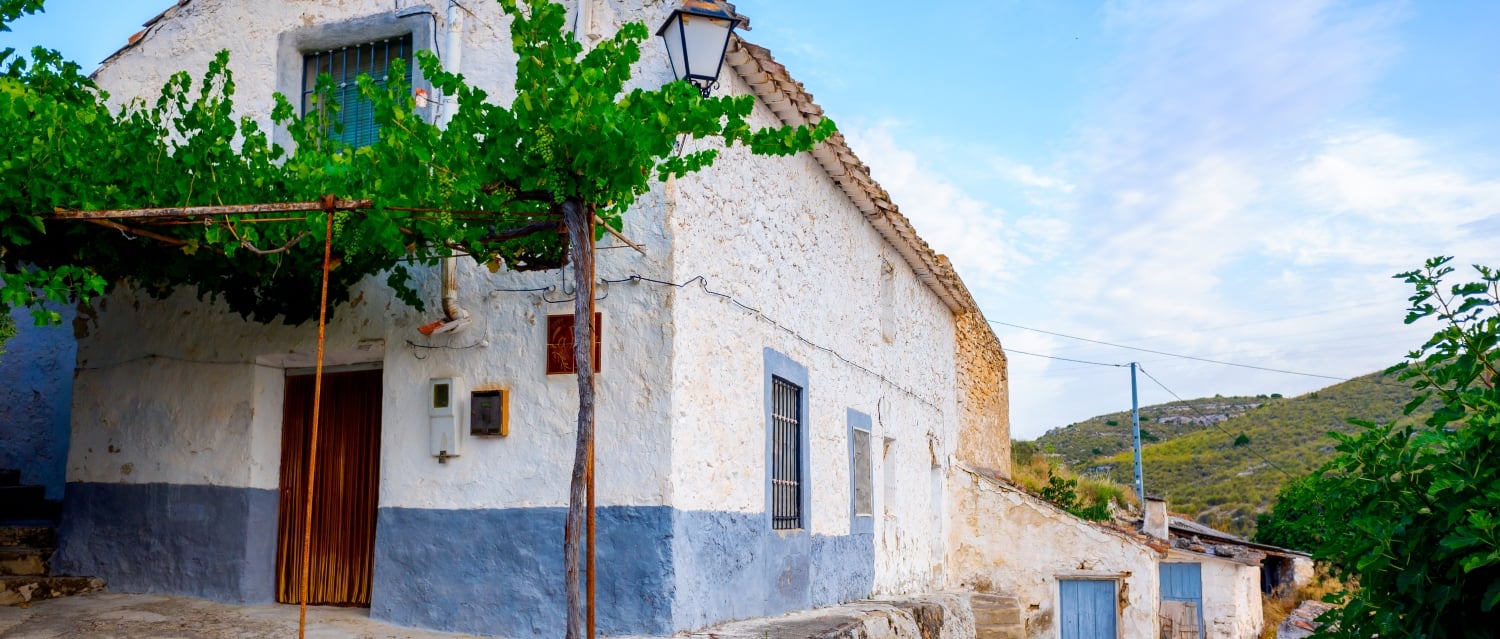Owning a home in Spain could be possible for less than you think. With smart research and the right timing, you can find genuine value – whether that’s a fixer-upper in Andalusia, an inland gem near Murcia or an off-plan apartment by the coast.
Looking to make your dream of owning a Spanish property a reality, but without the hefty price tag? It’s absolutely possible. Spain offers a wide range of affordable properties – if you know where and how to look. This guide explores how to find genuinely affordable Spanish property, even in today’s competitive market, and where to start your search.
Download the Spain Buying Guide
Contents
1. Consider fixer-uppers
One of the most effective ways to buy cheap property in Spain is to look for renovation projects. Known as “fixer-uppers,” these are homes that need some love – and potentially a full overhaul. While this might sound daunting, it could be your ticket to a dream property for much less.
Imagine picking up a village house in Jaén for less than €20,000! Yes, it may require a new roof and a total kitchen refit, but it also offers the chance to customise the home to your taste. Buyers from the UK and Northern Europe often overlook these properties in favour of turnkey homes, which creates opportunities for more flexible and adventurous buyers.
Before committing, it’s essential to:
- Hire a surveyor to assess structural issues
- Speak with a local lawyer about renovation permissions
- Request cost estimates from local builders before completing the purchase
If managed well, you could end up with a property that’s not only affordable but also has strong long-term value.
2. Look for off-plan opportunities
If you’re not in a rush, consider an off-plan development. These are properties sold before or during construction, typically with a completion horizon of 12-24 months. Developers often offer lower prices at launch to secure financing and build early momentum.
Let’s say you want a modern two-bedroom flat on the Costa Blanca. Buying off-plan could save you thousands and offer personalisation options – like choosing finishes or layouts. The caveat? You must be financially prepared for staged payments (usually 30% upfront) and open to the possibility of delays.

Before buying, make sure to:
- Research the developer’s history – have past projects been delivered on time and to standard?
- Check for a legally required bank guarantee to protect your deposits
- Have your lawyer review the sales contract thoroughly
This route suits investors and those who aren’t in a hurry to relocate but want modern, energy-efficient design at a reduced price.
Download the Off-Plan Buying Guide
3. Go off the beaten track
If you’re willing to trade a sea view for a short drive – or an easy cycle – you could save tens of thousands on your Spanish home. Just five or ten minutes inland from the coast, prices can drop dramatically, while local bakeries, tapas bars and weekly markets keep daily life just as convenient. Go a little further, and you’ll discover places where your budget stretches far beyond what you’d get by the beach.
Of course, no one wants a half-hour trek to the sea in the midday sun. Luckily, scooters and e-bikes are common in Spain, so there’s an easy fix. Zip to the coast in style, enjoy the breeze and blend right in with the locals – it’s cheaper, greener and a lot more fun than sitting in traffic!
For inspiration, start your inland search in:
- Teruel (Aragón): Surrounded by rolling countryside and historic architecture, this inland gem is just over an hour’s drive from the beach – and you’ll find houses from around €50,000.
- Ponga (Asturias): In Spain’s lush green north, the market is so calm the local council once offered incentives for new buyers. If you love mountain air and quiet village life, this could be your spot.
- Lorca (Murcia): Within easy reach of the Costa Cálida, but typically 30–40% cheaper than coastal resorts, Lorca offers traditional Spanish life with beaches still close enough for weekend trips.
4. Buy at the right time
When you buy can be just as important as where you buy. In Spain, winter is often the quietest period for the property market. That’s when sellers – especially holiday-home owners – may be more open to negotiation.
Between November and February, competition from other buyers drops, and some sellers are eager to offload properties to avoid the upcoming year’s tax or maintenance burden. That’s your chance to make a serious offer and strike a better deal.
Stay informed by tracking regional sales trends through resources like the Spanish Land Registry website. The longer a property has been on the market, the more negotiating power you may have.
5. Learn how to negotiate
Haggling isn’t rude in Spain – it’s part of the process. Especially outside of tourist-heavy zones, buyers are expected to negotiate, and a 5-10% reduction isn’t uncommon. But you’ll need to come prepared.
Tips for successful negotiation:
- Know the average price per m² in the area (available via registradores.org)
- Get a second opinion from a surveyor or independent advisor – not just the selling agent
- Ask how long the property has been on the market – sellers with time pressure may accept a lower offer
Buyers from countries like the UK often have more experience with fixed-price markets, but embracing Spain’s more flexible approach can lead to huge savings.
Understanding additional costs
No matter how affordably you buy, you’ll still need to budget for associated costs. On average, expect an extra 10-14% on top of the purchase price for legal and administrative fees.
- Property transfer tax (ITP): 6-10% depending on the region
- Legal fees: around 1-2%
- Notary, registry and admin fees: 1-2.5%
These fees can be at the higher end of the scale for lower-value properties. However, they’re essential to ensure your ownership is properly registered and protected.
Final thoughts
Spain remains one of the best places in Europe to find an affordable home. From fixer-uppers to off-plan options, inland towns to negotiation tactics, you have a wide toolkit at your disposal.
Want to take the next step? Start browsing thousands of vetted properties today.
Search homes for sale in Spain
FAQs about cheap property in Spain
Inland regions such as Jaén (Andalusia), Teruel (Aragón) and parts of Extremadura consistently offer some of Spain’s lowest property prices. You can often find village houses under €50,000 – or even less if you’re open to renovation. These areas are ideal for budget-conscious buyers who don’t need to be near the coast.
Yes – if you’ve done your research and are financially prepared. Property prices in Spain remain competitive in many regions, and with stabilising mortgage rates and strong long-term demand, many buyers are seeing now as a good time to enter the market. Just be sure to factor in legal fees, taxes and currency fluctuations.
Popular regions for British buyers include the Costa Blanca, Costa del Sol and Murcia. These areas offer good infrastructure, international communities, accessible healthcare and a wide range of affordable properties. Inland towns just a short drive from the coast – like Lorca or Ontinyent – can offer even better value.
You might also like:
- How to save money when buying property in Spain
- Why buying property in Spain is a good idea
- How to find a Spanish estate agent you can rely on









